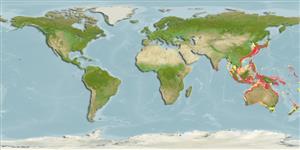Environment: milieu / climate zone / depth range / distribution range
Écologie
marin démersal. Tropical
Western Pacific: southern Japan, southern Indonesia, and northwestern Australia (Ref. 5978). Reported from Taiwan (Ref. 5193).
Taille / Poids / Âge
Maturity: Lm ? range ? - ? cm
Max length : 8.5 cm SL mâle / non sexé; (Ref. 9824)
Épines dorsales (Total) : 0; Rayons mous dorsaux (Total) : 81 - 93; Épines anales: 0; Rayons mous anaux: 62 - 71. This species differs from other members of the genus by having dark spots along the upper and lower edges of its body, extending to basal part of the dorsal and anal fins, posterior part of the caudal fin and a dark band, upper limb of gill arch with gill rakers. This genus is characterized by having eyes separated by a bony ridge of very narrow space anteriorly and a ridge posteriorly, a small mouth about equal to eye diameter, ctenoid scales on ocular side armed with a row of hairlike spines.
Inhabits sand and mud bottoms (Ref. 9824). Feeds on small polychaetes, crustaceans, and fishes (Ref. 9824). Caught mainly with bottom shrimp trawls (Ref. 9824).
Life cycle and mating behavior
Maturities | Reproduction | Spawnings | Egg(s) | Fecundities | Larves
Masuda, H., K. Amaoka, C. Araga, T. Uyeno and T. Yoshino, 1984. The fishes of the Japanese Archipelago. Vol. 1. Tokai University Press, Tokyo, Japan. 437 p. (text). (Ref. 559)
Statut dans la liste rouge de l'IUCN (Ref. 130435)
Menace pour l'homme
Harmless
Utilisations par l'homme
Pêcheries: sans intérêt
Outils
Articles particuliers
Télécharger en XML
Sources Internet
Estimates based on models
Preferred temperature (Ref.
123201): 16.7 - 27.9, mean 24.9 °C (based on 446 cells).
Phylogenetic diversity index (Ref.
82804): PD
50 = 0.5010 [Uniqueness, from 0.5 = low to 2.0 = high].
Bayesian length-weight: a=0.00912 (0.00408 - 0.02036), b=3.05 (2.87 - 3.23), in cm total length, based on LWR estimates for this (Sub)family-body shape (Ref.
93245).
Niveau trophique (Ref.
69278): 3.7 ±0.53 se; based on food items.
Résilience (Ref.
120179): Haut, temps minimum de doublement de population inférieur à 15 mois (Preliminary K or Fecundity.).
Fishing Vulnerability (Ref.
59153): Low vulnerability (10 of 100).
